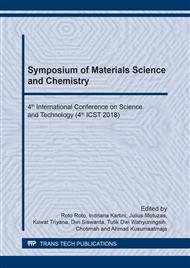p.243
p.249
p.254
p.260
p.267
p.274
p.279
p.287
p.294
Thermal and Microstructural Study on Mullite-Based Ceramics from Rice Husk-Alumina Mixtures
Abstract:
This study focuses on the physical and microstructural properties of mullite-based ceramic synthesized by solid-state reaction of rice husk ash (RHA) and alumina (Al2O3). Laser Flash analysis (LFA), Field Emission Scanning Electron Microscopy (FESEM) and Energy-dispersive X-ray spectroscopy (EDX) characterized the effects of the mixtures of RHA and Al2O3 matrix. The results show that the Al2O3rich samples sintered at 1500 °C exhibit the highest thermal diffusivity radiated at 500 °Cwith values varied from 0.258-0.369 mm2/s. The addition of Al2O3 (30-60 wt.%) into RHA enhance the crystallization of mullite on the surface of vitreous particles. The presence of diphasic mullite densified the green bodies,and its crystallites size keep increases (400.78-650.52 nm) by theincrement of the sintering temperature (1200-1500 °C). These results suggested that addition of Al2O3into RHA enhance the thermal diffusivity as the values closer to the thermal diffusivity of pure mullite and have high potential application as thermal insulation material. The properties of mullite-based ceramics listed above such samples M1, where the composition closes to mullite (3:2) have comparable properties to commercialize mullite ceramics.
Info:
Periodical:
Pages:
274-278
Citation:
Online since:
March 2019
Keywords:
Price:
Сopyright:
© 2019 Trans Tech Publications Ltd. All Rights Reserved
Share:
Citation:


